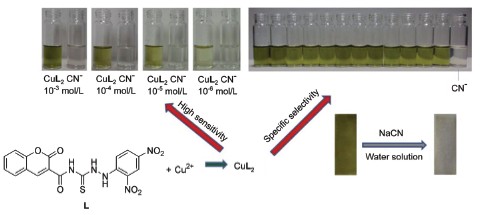| [1] Young, C.; Tidwell, L.; Anderson, C. Cyanide: Social, Industrial, and Economic Aspects, Minerals, Metals, and Materials Society, Warrendale, 2001. [2] Baud, F. J.; Hum, E. Toxicol. 2007, 26, 191. [3] Koening, R. Science 2000, 287, 1737. [4] Anderson, R. A.; Harland, W. A. Med. Sci. Law 1982, 22, 35. [5] Zamecnik, J.; Tam, J. J. Anal. Toxicol. 1987, 11, 47. [6] Way, J. L. Annu. Rev. Pharmacol. 1984, 24, 451. [7] Yen, S.; Wang, C. T.; Wang, J. S. Chem. Eng. Commun. 1991, 109, 167. [8] Bhalla, V.; Singh, H.; Kumar, M. Dalton Trans. 2012, 41, 11413. [9] Chattaraj, S.; Das, A. K. Analyst 1991, 116, 739. [10] Bark, L. S.; Higson, H. G. Analyst 1963, 88, 751. [11] Zhang, Y.-M.; Shi, B.-B.; Zang, P.; Huo, J. Q.; Chen, P.; Lin, Q.; Liu, J.; Wei, T.-B. Sci. China, Chem. 2013, 56, 612. [12] Liu, S.-Y.; Wang, F.-J.; Wei, L.-H.; Xiao, W.; Meng, L.-Z.; He, Y.-B. Sci. China, Ser. B 2003, 33, 504. (刘顺英, 王法军, 隗兰花, 肖旺, 孟令芝, 何永炳, 中国科学B辑, 2003, 33, 504.)[13] Zhang, Y.-M.; Lin, Q.; Wei, T.-B.; Wang, D.-D. Sens. Actuators, B 2009, 137, 447. [14] Yang, Y.-M.; Zhao, Q.; Feng, W.; Li, F.-Y. Chem. Rev. 2013, 113, 192. [15] Lin, Q.; Fu, Y.-P.; Chen, P.; Wei, T.-B.; Zhang, Y.-M. Dyes Pigm. 2013, 96, 1. [16] Zhang, Y.-M.; Lin, Q.; Wei, T.-B.; Li, Y.; Qin, X.-P. Chem. Commun. 2009, 6074. [17] Fang, X.-L.; Gao, B.-J.; Huang, X.-W.; Zhang, Y.-Q.; Gu, L.-Y. Acta Chim. Sinica 2012, 70, 2452. (房晓琳, 高保娇, 黄小卫, 张永奇, 顾来沅, 化学学报, 2012, 70, 2452.)[18] Liu, Z.-Q.; Shi, M.; Li, F.-Y.; Fang, Q.; Chen, Z.-H.; Yi, T.; Huang, C.-H. Org. Lett. 2005, 7, 5481. [19] Du, J.-M.; Gao, B.-J.; Huang, X.-W.; Zhang, Y.-Q.; Wang, M.-J. Acta Chim. Sinica 2012, 70, 1831. (杜俊玫, 高保娇, 黄小卫, 张永奇, 王明娟, 化学学报, 2012, 70, 1831.)[20] Lin, Q.; Wei, T.-B.; Yao, H.; Zhang, Y.-M. Acta Chim. Sinica 2007, 65, 159. (林奇, 魏太保, 姚虹, 张有明, 化学学报, 2007, 65, 159.)[21] Mao, J.; Wang, L.-N.; Dou, W.; Tang, X.-L.; Yan, Y.; Liu, W.-S. Org. Lett. 2007, 9, 4567. [22] Tang, X.-L.; Peng, X.-H.; Dou, W.; Mao, J.; Zheng, J.-R.; Qin, W.-W.; Liu, W.-S.; Chang, J.; Yao, X.-J. Org. Lett. 2008, 10, 3653. [23] Huang, X.-H.; Zhang, G.-X.; Zhang, D.-Q. Acta Chim. Sinica 2012, 70, 2133. (黄显虹, 张关心, 张德清, 化学学报, 2012, 70, 2133.)[24] Ma, W.-H.; Xia, W.; Xu, Q.; Han, H.-Y.; Song, B.; Sun, L.-W.; Liang, C.-H. Acta Chim. Sinica 2012, 70, 917. (马文辉, 夏威, 徐群, 韩宏彦, 宋波, 孙丽微, 梁春花, 化学学报, 2012, 70, 917.)[25] Liu, G.; Shao, J. Acta Chim. Sinica 2011, 69, 1070. (刘阁, 邵杰, 化学学报, 2011, 69, 1070.)[26] Saha, S.; Ghosh, A.; Mahato, P.; Mishra, S.; Mishra, S. K.; Suresh, E.; Das, S.; Das, A. Org. Lett. 2010, 12, 3406. [27] Kumar, V.; Kaushik, M. P.; Srivastava, A. K.; Pratap, A. Thiruvenkatam, V.; Row, T. N. Anal. Chim. Acta 2010, 663, 77. [28] Odago, M. O.; Colabello, D. M.; Lees, A. J. Tetrahedron 2010, 66, 7465. [29] Kumari, N.; Jha, S.; Bhattacharya, S. J. Org. Chem. 2011, 76, 8215. [30] Yao, L.-M.; Zhou, J.; Liu, J.-L.; Feng, W.; Li, F.-Y. Adv. Funct. Mater. 2012, 22, 2667. [31] Lin, Q.; Chen P.; Fu, Y.-P.; Zhang, Y.-M.; Shi, B.-B.; Zhang, P.; Wei, T.-B. Chin. Chem. Lett. 2013, 24, 699. [32] Yang, L.; Li, X.; Yang, J.-B.; Qu, Y.; Hua, J.-L. Appl. Mater. Interfaces 2013, 5, 1317. [33] Jo, J.; Olasz, A.; Chen, C. H.; Lee, D. J. Am. Chem. Soc. 2013, 135, 3620. [34] Duan, Y.-L.; Zheng, Y.-S. Talanta 2013, 107, 332. [35] Lee, J. H.; Jeong, A.; Shin, I. S.; Kim, H. J.; Hong, J. I. Org. Lett. 2010, 12, 764. [36] Zelder, F. H. Inorg. Chem. 2008, 47, 1264. [37] Guo, Y.-Y.; Tang, X.-L.; Hou, F.-P.; Wu, J.; Dou, W.; Qin, W.-W.; Ru, J.-X.; Zhang, G.-L.; Liu, W.-S.; Yao, X.-J. Sens. Actuators, B 2013, 181, 202. [38] Kim, M. H.; Kim, S.; Jang, H. H.; Yi, S. J.; Seo, S. H.; Han, M. S. Tetrahedron Lett. 2010, 51, 4712. [39] Lou, X.-D.; Zhang, Y.; Qin, J.-G.; Li, Z. Chem. Eur. J. 2011, 17, 9691. [40] Lin, Q.; Chen, P.; Liu, J.; Fu, Y.-P.; Zhang, Y.-M.; Wei, T.-B. Dyes Pigm. 2013, 98, 100.[41] Analytical Methods Committee, Analyst 1987, 112, 199. |
